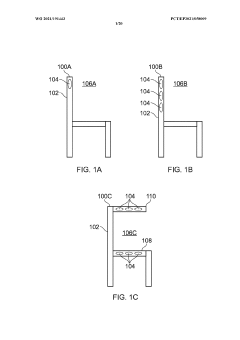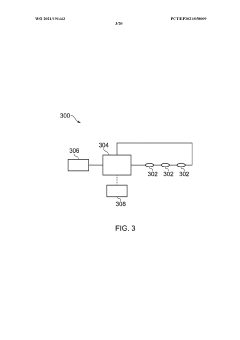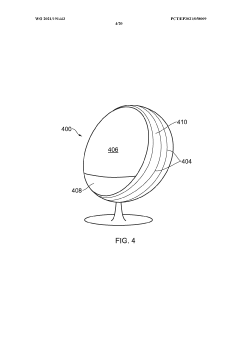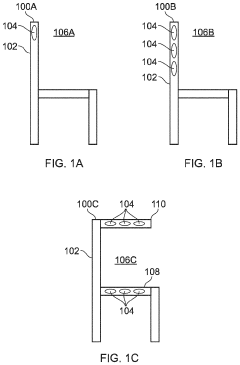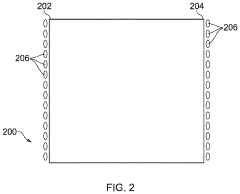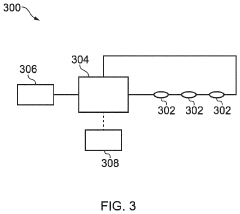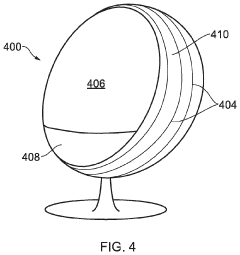Schumann Resonance’s Role in Earth’s Electromagnetic Field
JUN 24, 20259 MIN READ
Generate Your Research Report Instantly with AI Agent
Patsnap Eureka helps you evaluate technical feasibility & market potential.
Schumann Resonance Background and Objectives
The Schumann resonance, discovered by physicist Winfried Otto Schumann in 1952, is a set of spectrum peaks in the extremely low frequency (ELF) portion of the Earth's electromagnetic field. This natural phenomenon occurs in the Earth-ionosphere cavity, a region between the Earth's surface and the lower edge of the ionosphere. The resonance is primarily excited by lightning discharges worldwide, creating a constant background of electromagnetic waves.
The fundamental frequency of the Schumann resonance is approximately 7.83 Hz, with subsequent harmonics occurring at approximately 14.3, 20.8, 27.3, and 33.8 Hz. These frequencies are not constant and can vary due to various factors, including solar activity, ionospheric conditions, and global weather patterns. The study of Schumann resonances has become increasingly important in understanding the Earth's electromagnetic environment and its potential impacts on various systems.
The primary objective of researching Schumann resonances is to gain a deeper understanding of the Earth's electromagnetic field and its interactions with various natural and artificial systems. This includes investigating the potential effects on biological systems, atmospheric processes, and technological applications. Additionally, researchers aim to explore the use of Schumann resonances as a tool for monitoring global lightning activity, climate change, and ionospheric conditions.
One of the key goals in this field is to develop more accurate models of the Earth-ionosphere cavity and the propagation of electromagnetic waves within it. This involves integrating data from various sources, including ground-based ELF receivers, satellite observations, and atmospheric models. By improving these models, scientists hope to enhance our ability to predict and interpret changes in the Earth's electromagnetic environment.
Another important objective is to investigate the potential applications of Schumann resonance monitoring in various fields. This includes exploring its use in earthquake prediction, space weather forecasting, and global climate monitoring. Researchers are also interested in understanding how human-made electromagnetic noise affects the detection and interpretation of Schumann resonances, and developing methods to mitigate these effects.
As technology continues to advance, there is a growing interest in the potential impact of Schumann resonances on sensitive electronic systems and communications. This has led to efforts to develop more robust electromagnetic shielding and interference mitigation techniques, particularly for critical infrastructure and sensitive scientific instruments.
The fundamental frequency of the Schumann resonance is approximately 7.83 Hz, with subsequent harmonics occurring at approximately 14.3, 20.8, 27.3, and 33.8 Hz. These frequencies are not constant and can vary due to various factors, including solar activity, ionospheric conditions, and global weather patterns. The study of Schumann resonances has become increasingly important in understanding the Earth's electromagnetic environment and its potential impacts on various systems.
The primary objective of researching Schumann resonances is to gain a deeper understanding of the Earth's electromagnetic field and its interactions with various natural and artificial systems. This includes investigating the potential effects on biological systems, atmospheric processes, and technological applications. Additionally, researchers aim to explore the use of Schumann resonances as a tool for monitoring global lightning activity, climate change, and ionospheric conditions.
One of the key goals in this field is to develop more accurate models of the Earth-ionosphere cavity and the propagation of electromagnetic waves within it. This involves integrating data from various sources, including ground-based ELF receivers, satellite observations, and atmospheric models. By improving these models, scientists hope to enhance our ability to predict and interpret changes in the Earth's electromagnetic environment.
Another important objective is to investigate the potential applications of Schumann resonance monitoring in various fields. This includes exploring its use in earthquake prediction, space weather forecasting, and global climate monitoring. Researchers are also interested in understanding how human-made electromagnetic noise affects the detection and interpretation of Schumann resonances, and developing methods to mitigate these effects.
As technology continues to advance, there is a growing interest in the potential impact of Schumann resonances on sensitive electronic systems and communications. This has led to efforts to develop more robust electromagnetic shielding and interference mitigation techniques, particularly for critical infrastructure and sensitive scientific instruments.
Earth's Electromagnetic Field Research Demand
The demand for research into Earth's electromagnetic field has grown significantly in recent years, driven by both scientific curiosity and practical applications. This global electromagnetic environment, which includes the Schumann resonances, plays a crucial role in various natural phenomena and technological systems.
In the scientific community, there is a pressing need to better understand the complex interactions between the Earth's magnetic field, ionosphere, and various atmospheric layers. Researchers are particularly interested in how these interactions influence climate patterns, weather systems, and even biological processes. The Schumann resonances, as a natural phenomenon closely tied to the Earth's electromagnetic field, have become a focal point for many studies aiming to unravel these connections.
From a technological perspective, the demand for electromagnetic field research is fueled by the increasing reliance on wireless communication systems and satellite-based technologies. As these systems become more sophisticated and ubiquitous, understanding and mitigating the effects of natural electromagnetic phenomena becomes crucial for ensuring their reliability and performance.
The aerospace industry has shown a growing interest in Earth's electromagnetic field research, particularly in relation to satellite operations and space weather forecasting. Accurate models of the Earth's electromagnetic environment are essential for predicting and mitigating the effects of solar storms and other space weather events on satellite systems and ground-based infrastructure.
In the field of geophysics, there is an ongoing demand for improved methods of monitoring and predicting seismic activity. Some researchers hypothesize that changes in the Earth's electromagnetic field, including variations in Schumann resonances, may be precursors to earthquakes. This has led to increased funding and research efforts aimed at exploring the potential for electromagnetic-based earthquake prediction systems.
The healthcare sector has also shown interest in electromagnetic field research, particularly in understanding the potential effects of natural and artificial electromagnetic fields on human health. This includes studies on the impact of Schumann resonances on circadian rhythms and overall well-being, as well as investigations into the possible therapeutic applications of controlled electromagnetic fields.
Environmental monitoring and climate change research have created additional demand for electromagnetic field studies. Scientists are exploring how changes in the Earth's magnetic field and related phenomena might serve as indicators of broader environmental shifts, potentially offering new insights into global climate dynamics.
As our understanding of the Earth's electromagnetic field grows, so does the demand for more sophisticated measurement and analysis tools. This has spurred innovation in sensor technologies, data processing algorithms, and modeling techniques, creating new opportunities for interdisciplinary collaboration and technological advancement.
In the scientific community, there is a pressing need to better understand the complex interactions between the Earth's magnetic field, ionosphere, and various atmospheric layers. Researchers are particularly interested in how these interactions influence climate patterns, weather systems, and even biological processes. The Schumann resonances, as a natural phenomenon closely tied to the Earth's electromagnetic field, have become a focal point for many studies aiming to unravel these connections.
From a technological perspective, the demand for electromagnetic field research is fueled by the increasing reliance on wireless communication systems and satellite-based technologies. As these systems become more sophisticated and ubiquitous, understanding and mitigating the effects of natural electromagnetic phenomena becomes crucial for ensuring their reliability and performance.
The aerospace industry has shown a growing interest in Earth's electromagnetic field research, particularly in relation to satellite operations and space weather forecasting. Accurate models of the Earth's electromagnetic environment are essential for predicting and mitigating the effects of solar storms and other space weather events on satellite systems and ground-based infrastructure.
In the field of geophysics, there is an ongoing demand for improved methods of monitoring and predicting seismic activity. Some researchers hypothesize that changes in the Earth's electromagnetic field, including variations in Schumann resonances, may be precursors to earthquakes. This has led to increased funding and research efforts aimed at exploring the potential for electromagnetic-based earthquake prediction systems.
The healthcare sector has also shown interest in electromagnetic field research, particularly in understanding the potential effects of natural and artificial electromagnetic fields on human health. This includes studies on the impact of Schumann resonances on circadian rhythms and overall well-being, as well as investigations into the possible therapeutic applications of controlled electromagnetic fields.
Environmental monitoring and climate change research have created additional demand for electromagnetic field studies. Scientists are exploring how changes in the Earth's magnetic field and related phenomena might serve as indicators of broader environmental shifts, potentially offering new insights into global climate dynamics.
As our understanding of the Earth's electromagnetic field grows, so does the demand for more sophisticated measurement and analysis tools. This has spurred innovation in sensor technologies, data processing algorithms, and modeling techniques, creating new opportunities for interdisciplinary collaboration and technological advancement.
Current Understanding and Challenges
The current understanding of Schumann Resonance's role in Earth's electromagnetic field has advanced significantly in recent years, yet several challenges remain. Schumann Resonances are global electromagnetic resonances generated and excited by lightning discharges in the cavity formed by the Earth's surface and the ionosphere.
Research has established that these resonances occur at extremely low frequencies, with the fundamental mode at approximately 7.83 Hz and subsequent harmonics at higher frequencies. Scientists now recognize that these resonances play a crucial role in the Earth's electromagnetic environment, influencing various atmospheric and ionospheric processes.
One of the key advancements in our understanding is the recognition of Schumann Resonances as a global phenomenon. Measurements from different locations around the world have confirmed the consistency of these resonances, highlighting their importance in maintaining the Earth's electromagnetic balance.
Recent studies have also revealed the potential influence of Schumann Resonances on biological systems. Some researchers suggest that these resonances may affect human circadian rhythms and cognitive functions, although the exact mechanisms and extent of these effects remain subjects of ongoing investigation.
Despite these advancements, several challenges persist in fully comprehending Schumann Resonance's role. One significant obstacle is the difficulty in isolating Schumann Resonance signals from other electromagnetic noise, particularly in urban environments. This challenge hampers accurate measurements and analysis of the resonances' subtle variations.
Another major challenge lies in understanding the complex interactions between Schumann Resonances and other atmospheric phenomena. The relationship between these resonances and climate change, for instance, remains poorly understood and requires further investigation.
The impact of solar activity on Schumann Resonances presents another area of uncertainty. While correlations have been observed between solar events and changes in resonance patterns, the precise mechanisms driving these interactions are not yet fully elucidated.
Furthermore, the potential applications of Schumann Resonance monitoring in fields such as earthquake prediction and global lightning detection face significant technical and theoretical hurdles. Developing reliable methods to extract meaningful data from Schumann Resonance measurements for these applications remains a challenge.
Lastly, the long-term effects of human-induced electromagnetic pollution on the natural Schumann Resonance patterns are not well understood. As human activities continue to alter the Earth's electromagnetic environment, assessing and mitigating potential impacts on these fundamental resonances becomes increasingly important.
Research has established that these resonances occur at extremely low frequencies, with the fundamental mode at approximately 7.83 Hz and subsequent harmonics at higher frequencies. Scientists now recognize that these resonances play a crucial role in the Earth's electromagnetic environment, influencing various atmospheric and ionospheric processes.
One of the key advancements in our understanding is the recognition of Schumann Resonances as a global phenomenon. Measurements from different locations around the world have confirmed the consistency of these resonances, highlighting their importance in maintaining the Earth's electromagnetic balance.
Recent studies have also revealed the potential influence of Schumann Resonances on biological systems. Some researchers suggest that these resonances may affect human circadian rhythms and cognitive functions, although the exact mechanisms and extent of these effects remain subjects of ongoing investigation.
Despite these advancements, several challenges persist in fully comprehending Schumann Resonance's role. One significant obstacle is the difficulty in isolating Schumann Resonance signals from other electromagnetic noise, particularly in urban environments. This challenge hampers accurate measurements and analysis of the resonances' subtle variations.
Another major challenge lies in understanding the complex interactions between Schumann Resonances and other atmospheric phenomena. The relationship between these resonances and climate change, for instance, remains poorly understood and requires further investigation.
The impact of solar activity on Schumann Resonances presents another area of uncertainty. While correlations have been observed between solar events and changes in resonance patterns, the precise mechanisms driving these interactions are not yet fully elucidated.
Furthermore, the potential applications of Schumann Resonance monitoring in fields such as earthquake prediction and global lightning detection face significant technical and theoretical hurdles. Developing reliable methods to extract meaningful data from Schumann Resonance measurements for these applications remains a challenge.
Lastly, the long-term effects of human-induced electromagnetic pollution on the natural Schumann Resonance patterns are not well understood. As human activities continue to alter the Earth's electromagnetic environment, assessing and mitigating potential impacts on these fundamental resonances becomes increasingly important.
Measurement Techniques and Instrumentation
01 Schumann resonance devices for health and wellness
Various devices have been developed to generate or simulate Schumann resonance frequencies for potential health benefits. These devices aim to create an electromagnetic environment similar to the Earth's natural resonance, which some believe can improve well-being, reduce stress, and enhance relaxation.- Schumann resonance devices for health and wellness: Various devices are designed to generate or utilize Schumann resonance frequencies for potential health benefits. These devices aim to simulate the natural electromagnetic frequencies of the Earth to promote relaxation, improve sleep quality, and enhance overall well-being. Some implementations include wearable devices, room-based generators, and portable units that emit Schumann resonance frequencies.
- Schumann resonance in environmental monitoring and prediction: Schumann resonance measurements are used in environmental monitoring systems to detect and analyze atmospheric phenomena. These systems can potentially predict natural disasters, monitor climate changes, and provide early warning for severe weather events. The technology involves sensors and data processing algorithms to interpret Schumann resonance signals for environmental applications.
- Integration of Schumann resonance in electronic devices: Electronic devices, including smartphones, tablets, and wearables, are being designed to incorporate Schumann resonance technology. These devices may include built-in generators or receivers to provide users with the potential benefits of Schumann resonance exposure in their daily lives. The integration aims to counteract the effects of artificial electromagnetic fields from modern technology.
- Schumann resonance in agriculture and plant growth: Applications of Schumann resonance in agriculture focus on improving plant growth and crop yields. Systems are designed to expose plants to Schumann resonance frequencies, potentially enhancing their natural growth processes, stress resistance, and overall health. This technology may be implemented in greenhouses, indoor farming setups, and traditional agricultural environments.
- Schumann resonance-based therapeutic devices: Therapeutic devices utilizing Schumann resonance frequencies are being developed for various medical applications. These devices aim to provide non-invasive treatments for conditions such as pain management, stress reduction, and sleep disorders. The technology may include specialized mats, chairs, or portable devices that emit Schumann resonance frequencies for therapeutic purposes.
02 Integration of Schumann resonance in therapeutic applications
Schumann resonance has been incorporated into various therapeutic applications and medical devices. These applications range from sleep aids to stress reduction tools, often combining Schumann resonance with other therapeutic modalities to enhance overall effectiveness.Expand Specific Solutions03 Schumann resonance in environmental monitoring and research
Devices and systems have been developed to measure and analyze Schumann resonance for environmental monitoring and scientific research. These tools can be used to study atmospheric phenomena, climate change, and potential correlations between Schumann resonance and various natural processes.Expand Specific Solutions04 Portable and wearable Schumann resonance devices
Innovations in portable and wearable technology have led to the development of personal Schumann resonance devices. These compact devices allow users to experience simulated Schumann resonance frequencies in various settings, potentially offering benefits such as improved focus and relaxation.Expand Specific Solutions05 Schumann resonance in electromagnetic shielding and protection
Research and development efforts have explored the use of Schumann resonance principles in electromagnetic shielding and protection applications. These innovations aim to mitigate the potential negative effects of artificial electromagnetic fields while maintaining the benefits of natural Earth resonances.Expand Specific Solutions
Key Research Institutions and Scientists
The study of Schumann Resonance's role in Earth's electromagnetic field is in a developing stage, with growing interest from both academic and commercial sectors. The market size for related technologies and applications is expanding, driven by increasing awareness of electromagnetic phenomena's impact on various fields. Companies like GroundMetrics, Inc. and Schlumberger are at the forefront of this research, leveraging their expertise in geophysical measurements. Academic institutions such as the University of Bern and California Institute of Technology are contributing significant research, while organizations like the Electronics & Telecommunications Research Institute are exploring potential applications. The technology's maturity is progressing, with companies like PGS Geophysical AS and Earth Energies Inc developing innovative measurement and analysis tools.
GroundMetrics, Inc.
Technical Solution: GroundMetrics has developed advanced electromagnetic sensing technology for subsurface imaging and monitoring. Their system likely incorporates Schumann resonance measurements to enhance Earth's electromagnetic field detection. The technology uses an array of surface sensors to capture low-frequency electromagnetic signals, including those in the Schumann resonance range. This data is then processed using proprietary algorithms to create high-resolution images of subsurface structures and monitor changes over time. The system can potentially detect subtle variations in the Earth's electromagnetic field related to Schumann resonances, providing insights into global atmospheric and ionospheric conditions.
Strengths: High sensitivity to low-frequency electromagnetic signals, non-invasive subsurface imaging capability. Weaknesses: May be affected by local electromagnetic noise, requires complex data processing.
Services Petroliers Schlumberger SA
Technical Solution: Schlumberger, a leader in oilfield services, has likely incorporated Schumann resonance monitoring into their geophysical exploration techniques. Their approach may involve using a network of electromagnetic sensors deployed across large areas to detect and analyze Schumann resonance signals. This data could be integrated with other geophysical measurements to improve subsurface characterization and potentially identify hydrocarbon deposits. The company's advanced data processing capabilities allow for the separation of Schumann resonance signals from other electromagnetic noise, enhancing the accuracy of Earth's electromagnetic field measurements. This technology could also be used for long-term monitoring of global electromagnetic phenomena.
Strengths: Global presence and extensive resources for large-scale deployment, advanced data processing capabilities. Weaknesses: Primary focus on oil and gas industry may limit broader applications of the technology.
Schumann Resonance Frequency Analysis
A magnetic field exposure system and uses thereof
PatentWO2021191443A1
Innovation
- A magnetic field exposure system generating an amplitude-modulated low frequency magnetic field with a carrier frequency of 360 to 450 Hz and a modulation frequency of 0.5 to 100 Hz, with a field strength of 0.5 to 250 mT, specifically designed to expose organic cells or tissues to improve cell survival, proliferation, reduce stress, and enhance well-being.
A magnetic field exposure system and uses thereof
PatentPendingUS20230372726A1
Innovation
- A magnetic field exposure system generating an amplitude-modulated low frequency magnetic field with a carrier frequency of 360 to 450 Hz and a modulation frequency of 0.5 to 100 Hz, providing a field strength of 0.5 to 250 μT, specifically designed to enhance cell survival, proliferation, reduce stress, and promote tissue regeneration.
Global Monitoring Network Development
The development of a global monitoring network for Schumann Resonances is crucial for understanding their role in Earth's electromagnetic field. This network aims to provide comprehensive, real-time data on these low-frequency electromagnetic waves that resonate in the cavity between the Earth's surface and the ionosphere.
Establishing such a network requires strategic placement of monitoring stations across the globe. These stations typically consist of sensitive magnetometers and electric field sensors capable of detecting the extremely low-frequency signals characteristic of Schumann Resonances. The ideal distribution of these stations would cover a wide range of latitudes and longitudes to capture global variations in the resonances.
One of the primary challenges in developing this network is the need for standardization of equipment and measurement protocols. To ensure data consistency and comparability across different locations, it is essential to use calibrated instruments and agreed-upon data processing techniques. This standardization facilitates the integration of data from multiple sources into a cohesive global picture of Schumann Resonance activity.
Data transmission and storage present another significant aspect of the network's development. Real-time or near-real-time data transfer from remote monitoring stations to central processing facilities is crucial for timely analysis and interpretation. This requires robust communication infrastructure, often relying on satellite links or high-speed internet connections in more accessible areas.
The processing and analysis of the collected data form a critical component of the network. Advanced signal processing techniques are necessary to extract Schumann Resonance signals from background noise and to identify variations in frequency, amplitude, and phase. Machine learning algorithms are increasingly being employed to automate this process and to detect subtle patterns or anomalies in the data.
Collaboration between international scientific institutions is fundamental to the success of a global monitoring network. Sharing of data, expertise, and resources among different countries and research organizations enhances the network's coverage and effectiveness. This collaborative approach also fosters a more comprehensive understanding of global electromagnetic phenomena.
As the network develops, it opens up new possibilities for research and applications. Long-term monitoring of Schumann Resonances can provide insights into global climate changes, lightning activity patterns, and potential correlations with geophysical and space weather events. The data collected by this network may also have implications for fields such as atmospheric science, geophysics, and even potential applications in early warning systems for natural disasters.
Establishing such a network requires strategic placement of monitoring stations across the globe. These stations typically consist of sensitive magnetometers and electric field sensors capable of detecting the extremely low-frequency signals characteristic of Schumann Resonances. The ideal distribution of these stations would cover a wide range of latitudes and longitudes to capture global variations in the resonances.
One of the primary challenges in developing this network is the need for standardization of equipment and measurement protocols. To ensure data consistency and comparability across different locations, it is essential to use calibrated instruments and agreed-upon data processing techniques. This standardization facilitates the integration of data from multiple sources into a cohesive global picture of Schumann Resonance activity.
Data transmission and storage present another significant aspect of the network's development. Real-time or near-real-time data transfer from remote monitoring stations to central processing facilities is crucial for timely analysis and interpretation. This requires robust communication infrastructure, often relying on satellite links or high-speed internet connections in more accessible areas.
The processing and analysis of the collected data form a critical component of the network. Advanced signal processing techniques are necessary to extract Schumann Resonance signals from background noise and to identify variations in frequency, amplitude, and phase. Machine learning algorithms are increasingly being employed to automate this process and to detect subtle patterns or anomalies in the data.
Collaboration between international scientific institutions is fundamental to the success of a global monitoring network. Sharing of data, expertise, and resources among different countries and research organizations enhances the network's coverage and effectiveness. This collaborative approach also fosters a more comprehensive understanding of global electromagnetic phenomena.
As the network develops, it opens up new possibilities for research and applications. Long-term monitoring of Schumann Resonances can provide insights into global climate changes, lightning activity patterns, and potential correlations with geophysical and space weather events. The data collected by this network may also have implications for fields such as atmospheric science, geophysics, and even potential applications in early warning systems for natural disasters.
Schumann Resonance Applications
Schumann resonances have found a wide range of applications across various fields, leveraging their unique properties and connection to Earth's electromagnetic field. In the realm of geophysics, these resonances serve as valuable tools for monitoring global lightning activity and studying the Earth's ionosphere. Scientists utilize Schumann resonance measurements to track changes in the ionosphere's lower boundary, providing insights into atmospheric dynamics and potential climate change indicators.
In the field of space weather research, Schumann resonances play a crucial role in understanding the interactions between solar activity and Earth's magnetosphere. By analyzing variations in Schumann resonance parameters, researchers can detect and study geomagnetic storms, solar flares, and other space weather phenomena that may impact satellite communications and power grids.
The medical and biological sciences have also explored potential applications of Schumann resonances. Some studies suggest that exposure to these natural electromagnetic frequencies may have beneficial effects on human health and well-being. This has led to the development of therapeutic devices and practices that aim to simulate or enhance exposure to Schumann resonances, although further research is needed to fully validate these claims.
In the field of telecommunications, Schumann resonances have been investigated as potential carriers for long-distance, low-frequency communication systems. While practical implementation remains challenging, the global nature of these resonances offers intriguing possibilities for worldwide communication networks that could operate with minimal infrastructure.
Environmental monitoring represents another significant application area for Schumann resonances. Changes in resonance characteristics can potentially indicate shifts in global temperature, humidity, and other atmospheric conditions. This makes Schumann resonance monitoring a valuable tool in climate change research and long-term environmental assessment.
The field of earthquake prediction has also explored the use of Schumann resonances. Some researchers hypothesize that pre-seismic electromagnetic phenomena may influence Schumann resonance parameters, potentially providing early warning indicators for major seismic events. While this application remains controversial and requires further validation, it highlights the diverse potential of Schumann resonance research.
In the field of space weather research, Schumann resonances play a crucial role in understanding the interactions between solar activity and Earth's magnetosphere. By analyzing variations in Schumann resonance parameters, researchers can detect and study geomagnetic storms, solar flares, and other space weather phenomena that may impact satellite communications and power grids.
The medical and biological sciences have also explored potential applications of Schumann resonances. Some studies suggest that exposure to these natural electromagnetic frequencies may have beneficial effects on human health and well-being. This has led to the development of therapeutic devices and practices that aim to simulate or enhance exposure to Schumann resonances, although further research is needed to fully validate these claims.
In the field of telecommunications, Schumann resonances have been investigated as potential carriers for long-distance, low-frequency communication systems. While practical implementation remains challenging, the global nature of these resonances offers intriguing possibilities for worldwide communication networks that could operate with minimal infrastructure.
Environmental monitoring represents another significant application area for Schumann resonances. Changes in resonance characteristics can potentially indicate shifts in global temperature, humidity, and other atmospheric conditions. This makes Schumann resonance monitoring a valuable tool in climate change research and long-term environmental assessment.
The field of earthquake prediction has also explored the use of Schumann resonances. Some researchers hypothesize that pre-seismic electromagnetic phenomena may influence Schumann resonance parameters, potentially providing early warning indicators for major seismic events. While this application remains controversial and requires further validation, it highlights the diverse potential of Schumann resonance research.
Unlock deeper insights with Patsnap Eureka Quick Research — get a full tech report to explore trends and direct your research. Try now!
Generate Your Research Report Instantly with AI Agent
Supercharge your innovation with Patsnap Eureka AI Agent Platform!
